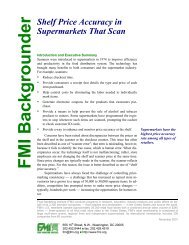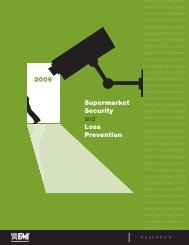GREATER ACCOUNTABILITY
GREATER ACCOUNTABILITY
GREATER ACCOUNTABILITY
You also want an ePaper? Increase the reach of your titles
YUMPU automatically turns print PDFs into web optimized ePapers that Google loves.
THE NEXT STEP: ALIGNMENTCREATING ALIGNMENTWithout clarity, there can be no alignment. The targeted resultmust be clear to everyone on the team and then the results mustbe shared. Each team member must share accountability forachieving the result.Many management teams confuse agreement and alignment.Alignment means that a team may have some measure ofagreement but not necessarily total agreement. This meansthat a team can have some disagreement and still be aligned.In fact, an organization cannot have true alignment withoutdisagreement.True alignment does not occur until people have had theopportunity and assume the accountability to say what theyreally think in a manner that lets them work issues throughand gain some buy-in. Disagreement inevitably accompaniesthe process, and that can be good. People who entirely disagreewith a course of action will find it difficult to stay in alignmentfor long.Alignment does, however, bring agreement--the agreementto move forward, the agreement to support the directionor decision, and the agreement to speak up if you becomeunaligned. It is essential to work with people to develop somelevel of agreement about where the organization is headedand why.Unfortunately, a company’s culture does not maintainalignment by itself. Alignment is a process, not an event. It is aprocess because the forces working to push the company out ofalignment are constant.“Our organization never seems to be aligned!”Companies frequently get mired in their attempts to gainalignment around their key results. Even the world’s mostsuccessful companies and leadership teams consistentlystruggle to create and maintain alignment.feeling accountable for such results. A company gets out ofalignment when managers work on isolated results. Having acommon focus and sharing accountability for key results keepsthem united. The quality control manager is as committedto achieving the bottom line as the financial manager iscommitted to quality. They share a sense of ownership for keyresults.MAINTAINING ALIGNMENTWhile managers need not agree with every decision, each ofthem must actively promote every senior management decision.This means owning the decision as if it were their own. This isessential to maintaining alignment. Leaders can promote aparticular decision in three important ways:1.2.3.Advocating a decision translates to more vigorous andproactive support.Sponsoring a decision involves taking vocalownership of the decision and linking your success toits success.Championing a decision means actively leadingpeople in efforts to make it a success and keeping it onthe daily agenda.Alignment does not require every senior manager to championevery decision, but when each leader champions or sponsorsthree or four key initiatives, the company makes greatprogress.The goal of alignment is to think and act as a team. Alignmentis not an event--it’s a process. There are always forces workingto throw the team out of alignment. Few of these forces canbe addressed effectively by changing the structure of theorganization. People will reliably produce results if they havean aligned team at the top leading them.Alignment begins at the top. It refers to a sharedunderstanding of the results the organization mustachieve, and of the actions needed to achieve those results.If a company is out of alignment, if people lack a sharedunderstanding of the targets and the means of achievingthem, organizational structure becomes a side issue. Theleadership team must create it, starting with themselves.Creating alignment means moving from just one managerfeeling accountable for quality, customer service, orfinancial performance to everyone in the organizationRESULTSWithout AlignmentRESULTSWith Alignment4Diagram 6 - Alignment On Results©2009 Partners In Leadership. All Rights Reserved.www.partnersinleadership.com | www.ozprinciple.com | Phone: 1-800-504-6070
















